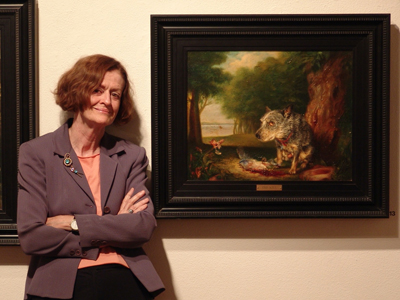

Bailey Doogan, artist who challenged stereotypes of age and beauty, has died Bailey Doogan, a Tucson artist well known for her large-scale, feminist paintings and charcoal drawings, died on July 4 at the age of 80. Born Margaret Mary Bailey on October 24, 1941 in Philadelphia, she was the daughter of William Mary Rowe and Edward William Bailey. She grew up in an Irish Catholic community and later said that growing up Catholic was one of the major influences on her artwork. Doogan (known as "Peggy" to friends and family) attended Moore College of Art and Design in Philadelphia. Although Moore had a fine arts program, Doogan, as the first person in her family to go to college, chose a more practical course of study and earned a bachelor's degree in illustration. Later during a sabbatical from her University of Arizona teaching position, Doogan completed a master's degree in animated film from the University of California in Los Angeles. Doogan moved to New York after completing her bachelor's degree and joined the graphic design firm DeMartin Marona and Associates where her award-winning designs and advertisements included the well-known Morton Salt Girl icon. Doogan's design of the girl carrying an umbrella and a leaking box of salt is still in use today with only a few minor revisions. Doogan moved to Tucson in 1969 to take up a position teaching graphic design at the University of Arizona. In 1982, she became a professor of design, painting and drawing. Doogan retired from the university in 1999 and became a UA professor emerita of painting and drawing. Many of her former art students still talk about what an inspiring role model she was for them and how she mentored them and helped them grow as artists. Doogan was always a part of Tucson's greater arts community and not just through the University of Arizona. When she first moved to Tucson, she lived at Rancho Linda Vista, an artists' community just north of Tucson that was an incubator for local artists. She married Ed Doogan and had her daughter Moira then. While her marriage was short lived, she began using the name "Margaret Bailey Doogan" personally and professionally. She later shortened her professional name to "Bailey Doogan." She also was an early member of the Dinnerware Artists' Cooperative Gallery (later Dinnerware Contemporary Arts), a driving force in Tucson's downtown arts scene during its 1980s and 1990s heyday. Ultimately, Doogan's artwork moved beyond its local origins. Her artwork was reviewed in numerous journals, including Art in America, ARTnews, The Nation, Ms., Art Journal and the New Art Examiner. SCREW, A Technical Love Poem, the animated film that she submitted as her 1977 master's thesis, is the only animated film that Doogan ever created. Yet it was shown in film festivals worldwide, including in the prestigious Venice Biennale (1979). Doogan was always interested in the realities of the national art scene. For her 1980s' series Articulate, she traveled around the country interviewing women artists, museum administrators and critics. Her exhibition held at the UA Museum of Art displayed colorful portraits of the women she interviewed while waves of their voices talking about their lives as women in the art world moved through the room. In the 1980s, some of Doogan's work, like her Punch and Judy series, featured bright colors and cartoonish figures that reflected her animation and advertising background. She also began working on her large-scale, charcoal drawings then. These striking pieces use techniques from the Italian Renaissance and reveal her drawing prowess in creating realistically rendered nudes and subtle backgrounds. Doogan's large-scale paintings from the 1990s and 2000s transform her nudes by using glazes and a palette knife to create thickly rendered images. Visually, these paintings have been compared to works by some of the most technically skilled painters in the Western tradition, including Thomas Eakins and Rembrandt. Yet the nudes in both Doogan's large-scale paintings and her charcoal drawings do not buy into the classical stereotype of idealized youthful beauty. These nudes present aged bodies, typically women's bodies, in all of their imperfections of wrinkles, flabby tissues and varicose veins. While these feminist images have been seen as controversial and provocative, for Doogan they were akin to an act of compassion. As she said, "For me, skin is beautiful because it is a luminous diary of experience." Generous, intelligent, creative, fearless, profound, brilliant, revolutionary, passionate, humorous, modest, an amazing artist - these are some of the words that Doogan's friends, former students and colleagues have used to describe her. She will be sorely missed by her family, friends and the greater Tucson arts community. Doogan is survived by her daughter Moira, her son-in-law Miguel, her sister Mary, her brother Ed, and her extended and chosen family who loved her dearly. A memorial service is planned for the winter on an as yet to be specified date. Friends may remember Margaret Bailey Doogan through a contribution made in her memory to one of her favorite nonprofit organizations, Planned Parenthood, Audubon Arizona or the Tucson Museum of Art. Photo courtesy Etherton Gallery. |